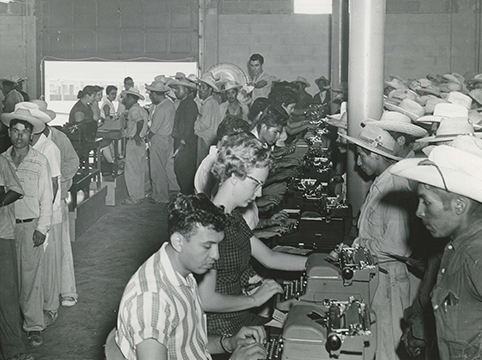Post-War Years
Immigration remained relatively low following World War II because the numerical limitations imposed by the 1920s national origins system remained in place. However, humanitarian crises spawned by the conflict and United States burgeoning international presence in the post-war world brought new challenges for the Immigration and Naturalization Service (INS).
Providing Humanitarian Relief
Many INS programs in the 1940s and 1950s addressed individuals affected by conditions in postwar Europe. The Displaced Persons Act of 1948 and Refugee Relief Act of 1953 allowed for admission of many refugees displaced by the war and unable to come to the United States under regular immigration procedures. With the onset of the Cold War, the Hungarian Refugee Act of 1956, Refugee-Escapee Act of 1957, and Cuban Adjustment Program of the 1960s served the same purpose for “escapees” from communist countries. Other post-war INS programs facilitated family reunification. The War Brides Act of 1945 and the Fiancées Act of 1946 eased admission of the spouses and families of returning American soldiers.

The Bracero Program
The World War II temporary worker program continued after the war under a 1951 formal agreement between Mexico and the United States. Like its wartime predecessor the Mexican Agricultural Labor Program (“MALP”), commonly called the “Bracero Program,” matched seasonal agricultural workers from Mexico with approved American employers. Between 1951 and 1964, hundreds of thousands of braceros entered the country each year as non-immigrant laborers.
Enforcing Immigration Laws
By the mid-1950s, INS enforcement activities focused on two areas of national concern. Public alarm over illegal noncitizens resident and working in the United States caused the Service to strengthen border controls and launch targeted deportation programs including the controversial "Operation Wetback," a 1954 Mexican Border enforcement initiative. Additional worry over criminal noncitizens within the country prompted INS investigation and deportation of communists, subversives, and organized crime figures.
Reforming Immigration Policy
Congress re-codified and combined all previous immigration and naturalization law into the Immigration and Nationality Act (INA) of 1952. The 1952 law removed all racial barriers to immigration and naturalization and granted the same preference to husbands as it did to wives of American citizens. However, the INA retained the national origins quotas.
In 1965 amendments to the 1952 immigration law Congress replaced the national origins system with a preference system designed to reunite immigrant families and attract skilled immigrants to the United States. This change to national policy responded to changes in the sources of immigration since 1924. By the mid-20th century, the majority of applicants for immigration visas came from Asia and Central and South America rather than Europe. The preference system continued to limit the number of immigration visas available each year, however, and Congress still responded to refugees with special legislation, as it did for Indochinese refugees in the 1970s. Not until the Refugee Act of 1980 did the United States have a general policy governing the admission of refugees.
